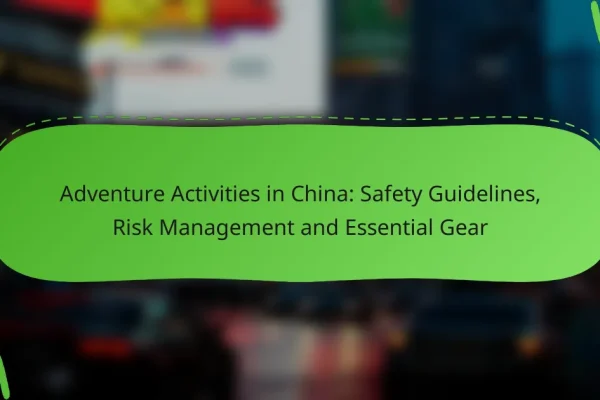What are the best adventure activities in China?
China offers a diverse range of adventure activities that cater to thrill-seekers and nature enthusiasts alike. From breathtaking hikes to exhilarating water sports, there is something for everyone looking to explore the country’s stunning landscapes.
Hiking in Zhangjiajie National Forest Park
Zhangjiajie National Forest Park is renowned for its towering sandstone pillars, which inspired the floating mountains in the movie “Avatar.” Hiking trails vary in difficulty, allowing both casual walkers and seasoned trekkers to enjoy the stunning scenery.
Visitors should consider the best seasons for hiking, typically spring and autumn, when temperatures are mild and the foliage is vibrant. Be prepared for steep ascents and ensure you have proper footwear to navigate the rugged terrain.
White-water rafting in the Yangtze River
The Yangtze River offers thrilling white-water rafting experiences, particularly in the sections around the Three Gorges. Rafting here can be an adrenaline-pumping adventure, with rapids ranging from class II to IV, depending on the season and water levels.
It’s essential to choose a reputable rafting company that provides safety gear and experienced guides. The best time for rafting is typically from late spring to early autumn, when water levels are optimal for adventure.
Rock climbing in Yangshuo
Yangshuo is famous for its limestone karst formations, making it a prime destination for rock climbing. The area offers routes for all skill levels, from beginner-friendly climbs to challenging ascents for experienced climbers.
Climbing in Yangshuo can be enjoyed year-round, but spring and autumn provide the most comfortable weather conditions. Joining a local climbing group can enhance the experience, offering guidance and camaraderie.
Skiing in Harbin
Harbin, known for its winter festivals, also offers excellent skiing opportunities at resorts like Yabuli and Songhua Lake. These resorts feature a range of slopes suitable for beginners to advanced skiers.
The ski season typically runs from December to March, with January being the peak month for snow quality. Visitors should book accommodations in advance, especially during the Chinese New Year holiday, when demand is high.
Paragliding in Lijiang
Lijiang provides stunning views of the Jade Dragon Snow Mountain, making it a popular spot for paragliding. This adventure activity allows participants to soar above breathtaking landscapes, offering a unique perspective of the region.
The best time for paragliding in Lijiang is during the dry season from April to October. Ensure you choose a certified paragliding operator to guarantee safety and an unforgettable experience.
Where can I find adventure tours in China?
Adventure tours in China can be found through local tour operators, specialized travel agencies, and online platforms. Each option offers unique experiences, catering to different preferences and budgets.
Local tour operators in Beijing
Beijing is home to numerous local tour operators that specialize in adventure activities. These companies often provide guided tours to popular destinations like the Great Wall, hiking in the surrounding mountains, or exploring the city’s historical sites.
When choosing a local operator, consider their experience, customer reviews, and the types of activities they offer. Many operators provide customizable packages, allowing you to tailor your adventure to your interests.
Adventure travel agencies in Chengdu
Chengdu, known for its proximity to natural wonders, has several adventure travel agencies that focus on outdoor activities. Popular options include trekking in the nearby mountains or visiting the famous panda reserves.
Look for agencies that offer group tours or private experiences, depending on your preference. It’s beneficial to inquire about safety standards and the qualifications of the guides to ensure a safe and enjoyable adventure.
Online platforms like Klook and Viator
Online platforms such as Klook and Viator provide a convenient way to book adventure tours in China. These websites aggregate various tour options, allowing you to compare prices, read reviews, and secure bookings easily.
When using these platforms, pay attention to cancellation policies and customer support options. It’s also wise to check for any additional fees that may apply, ensuring you understand the total cost before booking your adventure.
What are the safety considerations for adventure activities in China?
Safety considerations for adventure activities in China include understanding local regulations, being aware of emergency services, and preparing with the right gear. Proper planning and adherence to safety protocols can significantly enhance your experience while minimizing risks.
Health and safety regulations
China has various health and safety regulations that govern adventure activities, particularly in popular tourist areas. Regulations may vary by region, so it’s essential to check local laws and guidelines before participating in activities like rock climbing, rafting, or hiking.
Many adventure operators are required to comply with national safety standards, which may include equipment checks and staff training. Always choose licensed operators who prioritize safety and have a good reputation.
Emergency services availability
Emergency services in China can vary significantly between urban and rural areas. In major cities, emergency response times are generally quick, with well-established services available for medical emergencies and accidents.
In remote areas, access to emergency services may be limited. It is advisable to carry a mobile phone with local service and familiarize yourself with the nearest medical facilities and emergency contact numbers before embarking on your adventure.
Recommended gear and preparation
Proper gear is crucial for ensuring safety during adventure activities in China. Depending on the activity, this may include helmets, harnesses, life jackets, and appropriate footwear. Always check with your adventure provider for specific gear requirements.
Preparation also involves physical fitness and understanding the environmental conditions. For example, high-altitude trekking requires acclimatization, while water sports may necessitate knowledge of local currents and weather patterns. Carry a basic first aid kit and ensure you have adequate insurance coverage for adventure activities.
How to choose the right adventure activity in China?
Choosing the right adventure activity in China involves understanding your skill level, physical fitness, and the seasonal weather conditions. By evaluating these factors, you can select an activity that is both enjoyable and safe for your experience and abilities.
Assessing skill levels and experience
Start by honestly assessing your current skill levels and past experiences in adventure activities. For instance, if you have prior experience in rock climbing, you might consider more challenging routes in places like Yangshuo or Zhangjiajie.
Beginner-friendly options, such as guided hiking tours in the Great Wall, are available for those with limited experience. Always check the difficulty ratings provided by tour operators to ensure a match with your skills.
Evaluating physical fitness requirements
Different adventure activities in China have varying physical fitness requirements. For example, trekking in the Himalayas demands a higher level of fitness compared to leisurely bike rides in rural areas.
Consider your current fitness level and any health conditions before committing to an activity. If you are unsure, consult with a fitness professional or your doctor to gauge your readiness for more strenuous activities.
Considering seasonal weather conditions
Weather can significantly impact your adventure experience in China. For instance, the best time for trekking in Yunnan is typically from October to April when the weather is dry and mild.
Research the seasonal weather patterns for your chosen activity. Avoid monsoon seasons for activities like rafting or climbing, as heavy rains can lead to dangerous conditions. Always check local forecasts before your trip to ensure safe conditions for your adventure.
What are the costs associated with adventure activities in China?
The costs for adventure activities in China can vary widely based on the type of activity, location, and whether you choose guided tours or self-guided experiences. Generally, participants should budget for tour fees, equipment rentals, and travel insurance, which can collectively range from moderate to high depending on the specifics.
Average pricing for guided tours
Guided tours in China can range from around 500 CNY to over 3,000 CNY per person, depending on the activity and duration. For instance, a day hike in popular areas like Zhangjiajie National Forest Park may cost about 800 CNY, while multi-day trekking tours can exceed 2,000 CNY. Always check what is included in the price, such as meals, transportation, and entrance fees.
Equipment rental costs
Renting equipment for adventure activities is common and can be quite affordable. For example, renting a mountain bike may cost between 100 CNY to 300 CNY per day, while climbing gear can range from 150 CNY to 500 CNY, depending on the quality and type of equipment. It’s advisable to compare rental shops to find the best prices and ensure safety standards are met.
Travel insurance considerations
Travel insurance is essential for adventure activities, covering potential injuries or cancellations. Policies can range from 200 CNY to 1,000 CNY depending on coverage levels and duration. Look for plans that specifically cover adventure sports, as standard travel insurance may not include these activities. Always read the fine print to understand exclusions and limits on coverage.
What are the cultural aspects of adventure activities in China?
Adventure activities in China are deeply intertwined with local culture, traditions, and social norms. Engaging in these activities requires an understanding of regional customs and etiquette to enhance the experience and show respect to local communities.
Understanding local customs and etiquette
When participating in adventure activities in China, it’s essential to be aware of local customs. For instance, greeting locals with a slight bow or a nod can show respect, while using both hands to accept items is considered polite. Understanding these nuances can foster goodwill and enrich your interactions.
Additionally, dress codes may vary by region. In more conservative areas, modest clothing is appreciated, while in tourist-heavy spots, casual attire is generally acceptable. Always consider the local environment and culture when choosing your clothing for activities like hiking or climbing.
Lastly, be mindful of noise levels and personal space. In many Chinese communities, being overly loud or intrusive can be seen as disrespectful. Keep conversations at a moderate volume and respect the personal space of others, especially in rural areas where people may be more reserved.










